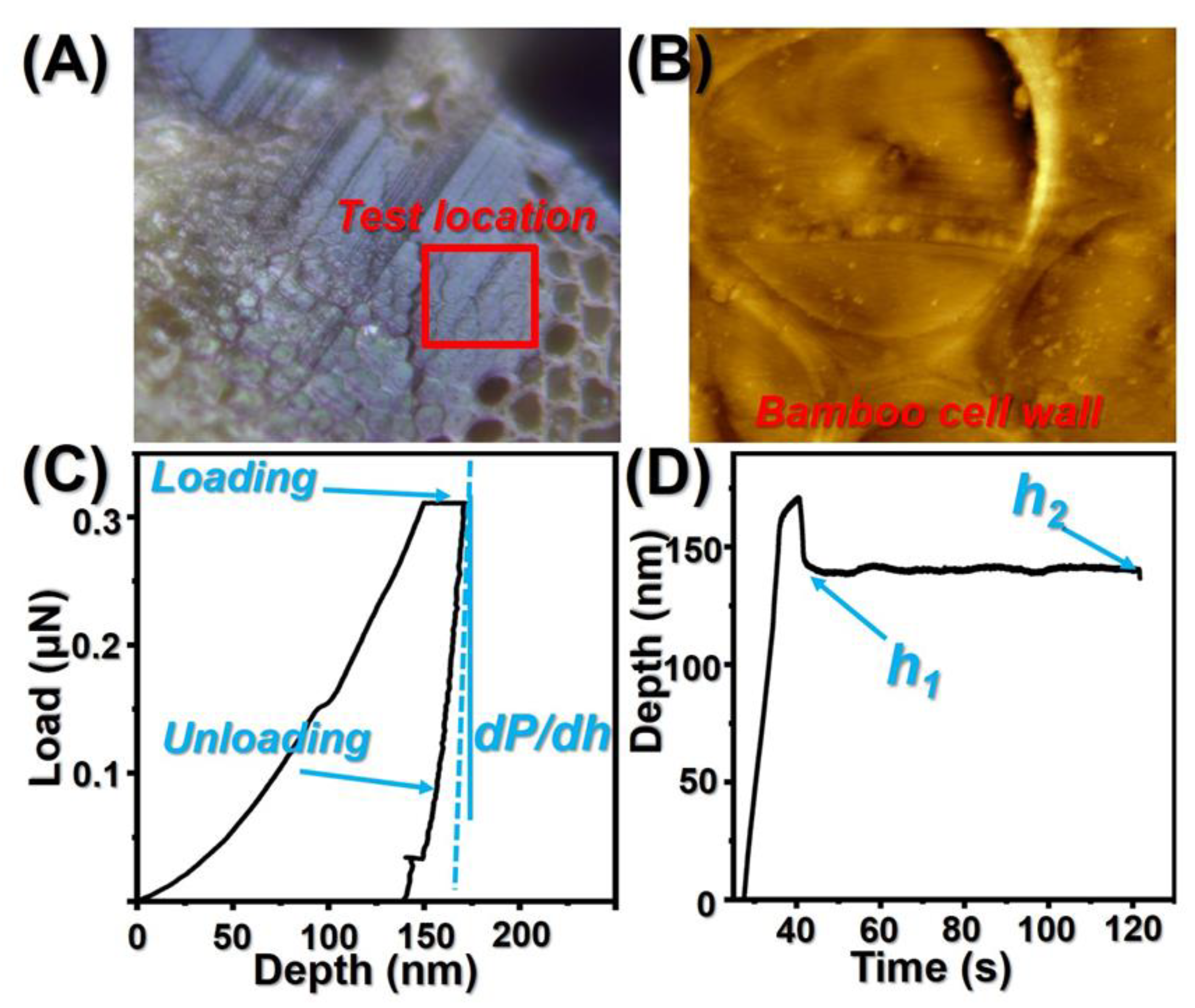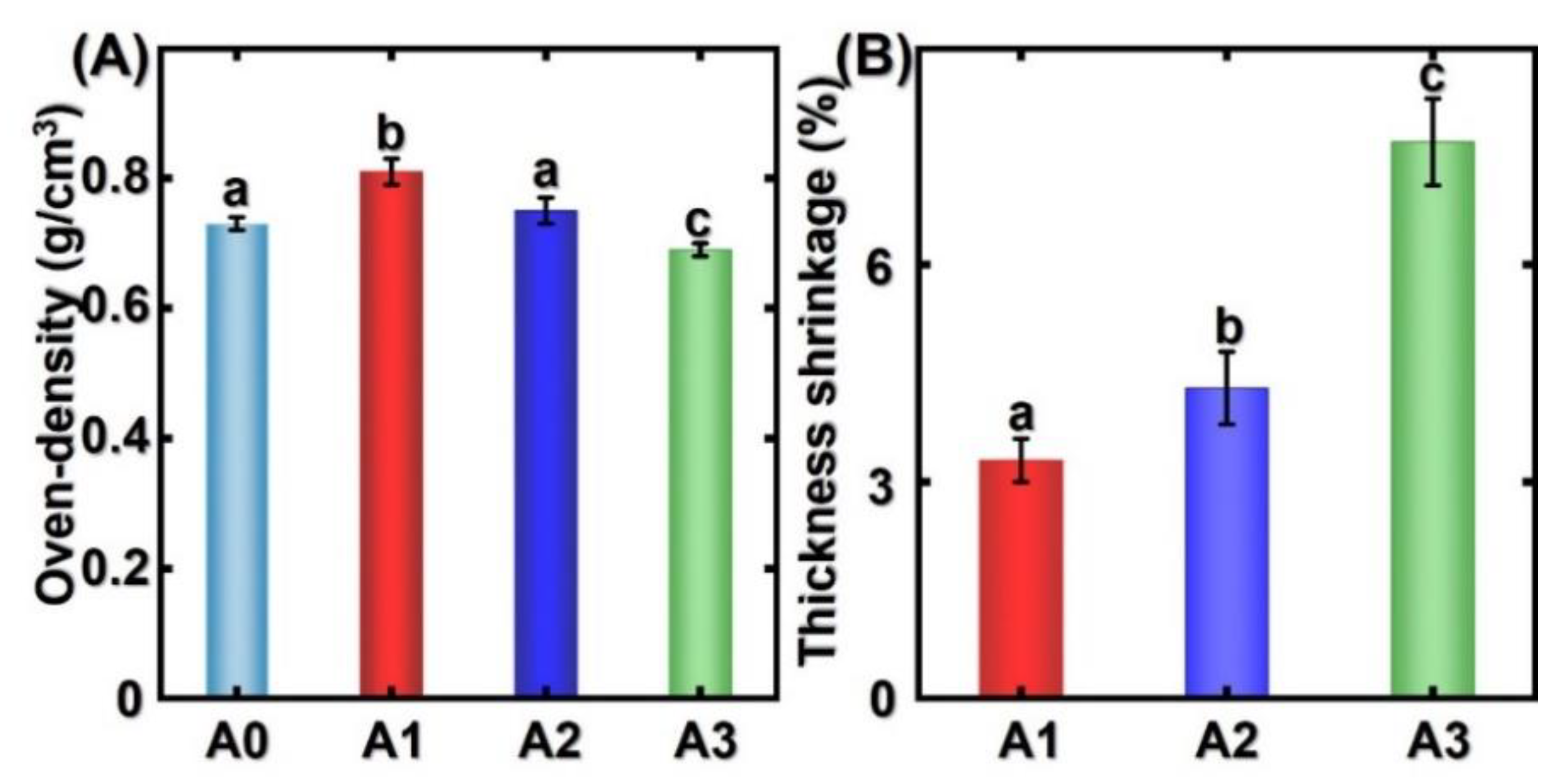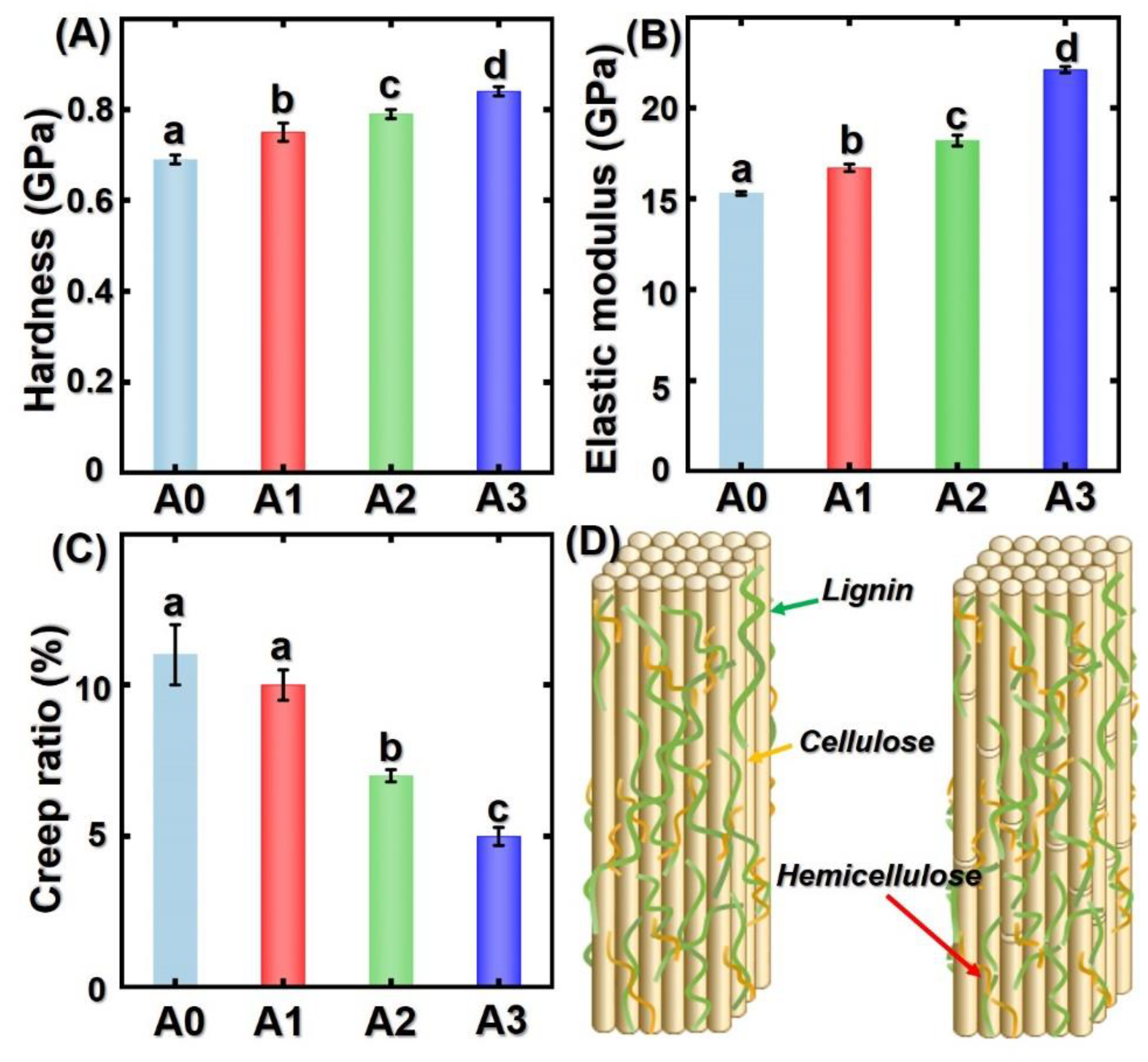Change in Micro-Morphology and Micro-Mechanical Properties of Thermally Modified Moso Bamboo
Abstract
:1. Introduction
2. Materials and Methods
2.1. Materials
2.2. X-ray Diffraction (XRD)
2.3. The Measurement of Oven-Dried Density and Thickness Shrinkage
2.4. Fourier Transform Infrared (FTIR)
2.5. Measurement of Chemical Compositions in Bamboo Specimens
2.6. Nanoindentation (NI)
2.7. Statistical Analysis
3. Results
3.1. SEM Analysis
3.2. Density and Thickness Shrinkage
3.3. Chemical Composition, XRD, and FTIR Analysis
3.4. Micro-Mechanical Properties of Bamboo Cell Walls
3.5. Proposed Mechanism
4. Conclusions
Author Contributions
Funding
Conflicts of Interest
References
- Yuan, T.; Han, X.; Wu, Y.; Hu, S.; Wang, X.; Li, Y. A new approach for fabricating crack-free, flattened bamboo board and the study of its macro-/micro-properties. Eur. J. Wood Prod. 2021, 79, 1531–1540. [Google Scholar] [CrossRef]
- Yuan, T.; Huang, Y.; Wang, X.; Liu, H.; Zhang, A.; Wang, Q.; Zhao, Y.; Han, H.; Weng, F.; Li, Y. Characterization of the Influence of Heat Compression on Bamboo Cell Walls by Nanoindentation. J. Nanoelectron. Optoelectron. 2021, 16, 1436–1443. [Google Scholar] [CrossRef]
- Tong, J.; Wang, X.; Kuai, B.; Gao, J.; Zhang, Y.; Huang, Z.; Cai, L. Development of transparent composites using wheat straw fibers for light-transmitting building applications. Ind. Crop. Prod. 2021, 170, 113685. [Google Scholar] [CrossRef]
- Liang, R.; Zhu, Y.-H.; Wen, L.; Zhao, W.-W.; Kuai, B.-B.; Zhang, Y.-L.; Cai, L.-P. Exploration of effect of delignification on the mesopore structure in poplar cell wall by nitrogen absorption method. Cellulose 2019, 27, 1921–1932. [Google Scholar] [CrossRef]
- Wang, J.; Wang, X.; He, Q.; Zhang, Y.; Zhan, T. Time-temperature-stress equivalence in compressive creep response of Chinese fir at high-temperature range. Constr. Build. Mater. 2020, 235, 117809. [Google Scholar] [CrossRef]
- Kuai, B.; Wang, X.; Lv, C.; Xu, K.; Zhang, Y.; Zhan, T. Orthotropic Tension Behavior of Two Typical Chinese Plantation Woods at Wide Relative Humidity Range. Forests 2019, 10, 516. [Google Scholar] [CrossRef] [Green Version]
- Liu, Z.; Wen, L.; Wang, X.; Zhang, Y.; Cai, L. Leachability of ACQ-D after three different preservative treatments. Wood Res. 2020, 65, 591–604. [Google Scholar] [CrossRef]
- Yuan, T.; Wang, X.; Lou, Z.; Zhang, T.; Han, X.; Wang, Z.; Hao, X.; Li, Y. Comparison of the fabrication process and macro and micro properties of two types of crack-free, flatten bamboo board. Constr. Build. Mater. 2021, 317, 125949. [Google Scholar] [CrossRef]
- Yuan, T.; Liu, X.; Dong, Y.; Wang, X.; Li, Y. Determination of the Effects of Superheated Steam on Microstructure and Micromechanical Properties of Bamboo Cell Walls Using Quasi-Static Nanoindentation. Forests 2021, 12, 1742. [Google Scholar] [CrossRef]
- Yuan, T.; Xiao, X.; Han, X.; Wu, Y.; Wang, X.; Liu, X.; Li, Y. Multi-Scale Analysis of Changes in Crack-Free Flattened Moso Bamboo After Saturated Steam Treatment and Flattening Process. Sci. Adv. Mater. 2021, 13, 1259–1267. [Google Scholar] [CrossRef]
- Yuan, T.; Xiao, X.; Zhang, T.; Yuan, Z.; Wang, X.; Li, Y. Preparation of crack-free, non-notched, flattened bamboo board and its physical and mechanical properties. Ind. Crop. Prod. 2021, 174, 114218. [Google Scholar] [CrossRef]
- Yuan, Z.; Wu, X.; Wang, X.; Zhang, X.; Yuan, T.; Liu, X.; Li, Y. Effects of One-Step Hot Oil Treatment on the Physical, Mechanical, and Surface Properties of Bamboo Scrimber. Molecules 2020, 25, 4488. [Google Scholar] [CrossRef]
- Wang, X.; Yuan, Z.; Zhan, X.; Li, Y.; Li, M.; Shen, L.; Cheng, D.; Li, Y.; Xu, B. Multi-scale characterization of the thermal–mechanically isolated bamboo fiber bundles and its potential application on engineered composites. Constr. Build. Mater. 2020, 262, 120866. [Google Scholar] [CrossRef]
- Yuan, T.; Wang, Z.; Han, X.; Yuan, Z.; Wang, X.; Li, Y. Multi-scale evaluation of the effect of saturated steam on the micromechanical properties of Moso bamboo. Holzforschung 2021, 75, 1052–1060. [Google Scholar] [CrossRef]
- Hao, X.; Wang, Q.; Wang, Y.; Han, X.; Yuan, C.; Cao, Y.; Lou, Z.; Li, Y. The effect of oil heat treatment on biological, mechanical and physical properties of bamboo. J. Wood Sci. 2021, 67, 1–14. [Google Scholar] [CrossRef]
- Wang, Q.; Wu, X.; Yuan, C.; Lou, Z.; Li, Y. Effect of Saturated Steam Heat Treatment on Physical and Chemical Properties of Bamboo. Molecules 2020, 25, 1999. [Google Scholar] [CrossRef]
- Wang, K.; Wang, Z.; Dong, Y.; Zhang, S.; Li, J. Coordination-Driven Controlled Assembly of Polyphenol-Metal Green Coating on Wood Micro-Grooved Surfaces: A Novel Approach to Stable Superhydrophobicity. Polymers 2017, 9, 347. [Google Scholar] [CrossRef] [PubMed] [Green Version]
- Wang, K.; Liu, X.; Tan, Y.; Zhang, W.; Zhang, S.; Li, J.; Huang, A. Highly fluorinated and hierarchical HNTs/SiO2 hybrid particles for substrate-independent superamphiphobic coatings. Chem. Eng. J. 2019, 359, 626–640. [Google Scholar] [CrossRef]
- Wang, K.; Dong, Y.; Ling, Z.; Liu, X.; Shi, S.Q.; Li, J. Transparent wood developed by introducing epoxy vitrimers into a delignified wood template. Compos. Sci. Technol. 2021, 207, 108690. [Google Scholar] [CrossRef]
- Wang, K.; Liu, X.; Tan, Y.; Zhang, W.; Zhang, S.; Li, J. Two-dimensional membrane and three-dimensional bulk aerogel materials via top-down wood nanotechnology for multibehavioral and reusable oil/water separation. Chem. Eng. J. 2019, 371, 769–780. [Google Scholar] [CrossRef]
- Zhou, X.; Cao, Y.; Yang, K.; Yu, P.; Chen, W.; Wang, S.; Chen, M. Clean plasma modification for recycling waste plastic bags: From improving interfacial adhesion with wood towards fabricating formaldehyde-free plywood. J. Clean. Prod. 2020, 269, 122196. [Google Scholar] [CrossRef]
- Cao, Y.; Zhang, W.; Yang, P.; Li, X.; Zhang, T.; Chen, W.; Wang, S.; Zhou, X. Comparative investigation into the interfacial adhesion of plywood prepared by air spray atomization and roller coating. Eur. J. Wood Prod. 2021, 79, 887–896. [Google Scholar] [CrossRef]
- Zhan, T.; Lyu, J.; Eder, M. In situ observation of shrinking and swelling of normal and compression Chinese fir wood at the tissue, cell and cell wall level. Wood Sci. Technol. 2021, 55, 1359–1377. [Google Scholar] [CrossRef]
- Chen, L.-S.; Fei, B.-H.; Ma, X.-X.; Lu, J.-P.; Fang, C.-H. Effects of Hygrothermal Environment in Cooling Towers on the Chemical Composition of Bamboo Grid Packing. Forests 2019, 10, 274. [Google Scholar] [CrossRef] [Green Version]
- Chen, H.; Zhang, W.; Wang, X.; Wang, H.; Wu, Y.; Zhong, T.; Fei, B. Effect of alkali treatment on wettability and thermal stability of individual bamboo fibers. J. Wood Sci. 2018, 64, 398–405. [Google Scholar] [CrossRef] [Green Version]
- Gan, W.; Chen, C.; Giroux, M.; Zhong, G.; Goyal, M.M.; Wang, Y.; Ping, W.; Song, J.; Xu, S.; He, S.; et al. Conductive Wood for High-Performance Structural Electromagnetic Interference Shielding. Chem. Mater. 2020, 32, 5280–5289. [Google Scholar] [CrossRef]
- Wang, X.; Xia, Q.; Jing, S.; Li, C.; Chen, Q.; Chen, B.; Pang, Z.; Jiang, B.; Gan, W.; Chen, G.; et al. Strong, Hydrostable, and Degradable Straws Based on Cellulose-Lignin Reinforced Composites. Small 2021, 17, 2008011. [Google Scholar] [CrossRef] [PubMed]
- Chen, C.; Kuang, Y.; Zhu, S.; Burgert, I.; Keplinger, T.; Gong, A.; Li, T.; Berglund, L.; Eichhorn, S.J.; Hu, L. Structure–property–function relationships of natural and engineered wood. Nat. Rev. Mater. 2020, 5, 642–666. [Google Scholar] [CrossRef]
- Dixon, P.G.; Semple, K.E.; Kutnar, A.; Kamke, F.A.; Smith, G.D.; Gibson, L.J. Comparison of the flexural behavior of natural and thermo-hydro-mechanically densified Moso bamboo. Eur. J. Wood Prod. 2016, 74, 633–642. [Google Scholar] [CrossRef] [Green Version]
- Banadics, E.A.; Tolvaj, L. Colour modification of poplar wood by steaming for brown colour. Eur. J. Wood Prod. 2019, 77, 717–719. [Google Scholar] [CrossRef] [Green Version]
- Wang, X.; Cheng, D.; Huang, X.; Song, L.; Gu, W.; Liang, X.; Li, Y.; Xu, B. Effect of high-temperature saturated steam treatment on the physical, chemical, and mechanical properties of moso bamboo. J. Wood Sci. 2020, 66, 1–9. [Google Scholar] [CrossRef]
- Wang, X.; Chen, X.; Xie, X.; Yuan, Z.; Cai, S.; Li, Y. Effect of Phenol Formaldehyde Resin Penetration on the Quasi-Static and Dynamic Mechanics of Wood Cell Walls Using Nanoindentation. Nanomaterials 2019, 9, 1409. [Google Scholar] [CrossRef] [Green Version]
- Wang, X.; Zhao, L.; Xu, B.; Li, Y.; Wang, S.; Deng, Y. Effects of accelerated aging treatment on the microstructure and mechanics of wood-resin interphase. Holzforschung 2017, 72, 235–241. [Google Scholar] [CrossRef]
- Wang, X.; Zhao, L.; Deng, Y.; Li, Y.; Wang, S. Effect of the penetration of isocyanates (pMDI) on the nanomechanics of wood cell wall evaluated by AFM-IR and nanoindentation (NI). Holzforschung 2018, 72, 301–309. [Google Scholar] [CrossRef]
- Wang, X.; Song, L.; Cheng, D.; Liang, X.; Xu, B. Effects of saturated steam pretreatment on the drying quality of moso bamboo culms. Eur. J. Wood Prod. 2019, 77, 949–951. [Google Scholar] [CrossRef]
- Yuan, F.; Wei, S.; Zhichao, L.; Qiuyi, W.; Yihan, Z.; Yanjun, L. An industrial feasible and sustainable method for preparing fiberized bamboo-derived magnetic biomass carbon. J. Mater. Sci. Mater. Electron. 2021, 32, 26137–26150. [Google Scholar] [CrossRef]
- Zhao, Y.; Lou, Z.; Wang, Q.; Wang, Y.; Sun, W.; Li, Y. Thermal phase transition controlling electromagnetic wave absorption behavior of PAN fiber derived porous magnetic absorber. J. Mater. Sci. Mater. Electron. 2021, 32, 26007–26020. [Google Scholar] [CrossRef]
- Yang, L.; Lou, Z.; Han, X.; Liu, J.; Wang, Z.; Zhang, Y.; Wu, X.; Yuan, C.; Li, Y. Fabrication of a novel magnetic reconstituted bamboo with mildew resistance properties. Mater. Today Commun. 2020, 23, 101086. [Google Scholar] [CrossRef]
- Fang, C.-H.; Jiang, Z.-H.; Sun, Z.-J.; Liu, H.-R.; Zhang, X.-B.; Zhang, R.; Fei, B.-H. An overview on bamboo culm flattening. Constr. Build. Mater. 2018, 171, 65–74. [Google Scholar] [CrossRef]
- Ju, Z.; Zhan, T.; Zhang, H.; He, Q.; Hong, L.; Yuan, M.; Cui, J.; Cheng, L.; Lu, X. Strong, Durable, and Aging-Resistant Bamboo Composites Fabricated by Silver In Situ Impregnation. ACS Sustain. Chem. Eng. 2020, 8. [Google Scholar] [CrossRef]
- Ju, Z.; Zhan, T.; Zhang, H.; He, Q.; Yuan, M.; Lu, X. Preparation of functional bamboo by combining nano-copper with hemicellulose and lignin under high voltage electric field (HVEF). Carbohydr. Polym. 2020, 250, 116936. [Google Scholar] [CrossRef] [PubMed]





Publisher’s Note: MDPI stays neutral with regard to jurisdictional claims in published maps and institutional affiliations. |
© 2022 by the authors. Licensee MDPI, Basel, Switzerland. This article is an open access article distributed under the terms and conditions of the Creative Commons Attribution (CC BY) license (https://creativecommons.org/licenses/by/4.0/).
Share and Cite
Yuan, T.; Huang, Y.; Zhang, T.; Wang, X.; Li, Y. Change in Micro-Morphology and Micro-Mechanical Properties of Thermally Modified Moso Bamboo. Polymers 2022, 14, 646. https://doi.org/10.3390/polym14030646
Yuan T, Huang Y, Zhang T, Wang X, Li Y. Change in Micro-Morphology and Micro-Mechanical Properties of Thermally Modified Moso Bamboo. Polymers. 2022; 14(3):646. https://doi.org/10.3390/polym14030646
Chicago/Turabian StyleYuan, Tiancheng, Yaqian Huang, Tao Zhang, Xinzhou Wang, and Yanjun Li. 2022. "Change in Micro-Morphology and Micro-Mechanical Properties of Thermally Modified Moso Bamboo" Polymers 14, no. 3: 646. https://doi.org/10.3390/polym14030646





